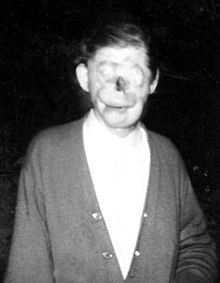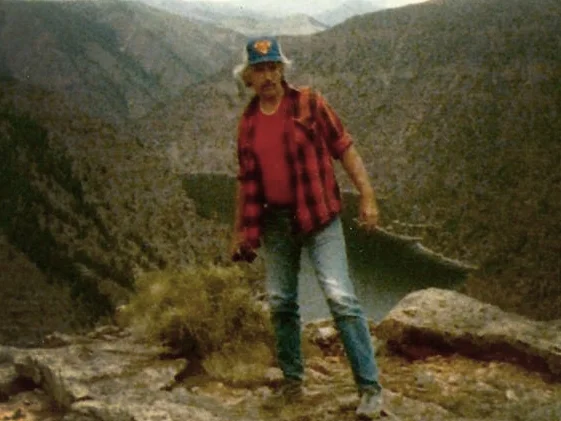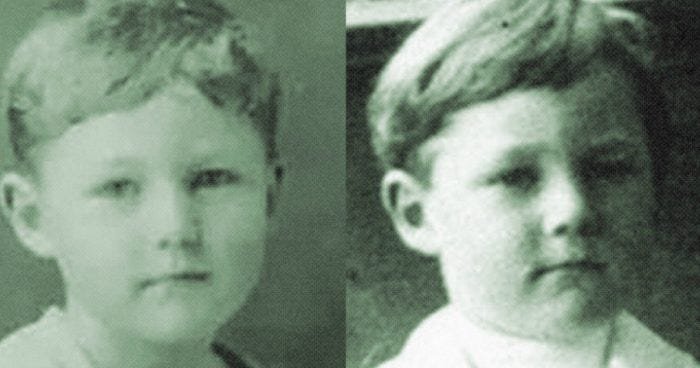If you drive through the sleepy towns of Western Pennsylvania, you might hear the locals speak of a ghostly figure who roams the dark roads at night.
A man with no eyes, ears, or any facial features at all, with skin that glows an eerie green color.


They call him The Green Man, a glowing phantom who haunted lonely roads and whispered tales of caution to those who dared venture out after dark.
As an outsider, you might think this story is too crazy to be true. But behind the myth of the Green Man was a real-life man named Raymond Robinson, whose life was as extraordinary as the legend that he became.
The true story of Raymond Robinson and the urban legends surrounding the Green Man have become so intertwined that it’s often difficult to separate fact from fiction.
In this article, we will peel back the layers of myth and folklore to uncover the true story of Raymond Robinson, the man behind The Green Man.
The Allure Of Urban Legends
Most urban legends start with a real-life event or person that, over time, becomes embellished and exaggerated until the facts are barely recognizable beneath the layers of myth.
In almost every small town across America, you’ll find some sort of local legend.
Whether it’s Bigfoot or the Goatman, these myths often become a source of pride for the people living there.
Over time, these legends become more than just spooky stories; they become part of the local lore, a source of pride and identity that holds the community together.
Even if we know better than to believe these stories, there’s an undeniable thrill in embracing urban legends.
The tale of the Green Man is one such legend, rooted in the extraordinary life of Raymond Robinson. His nightly walks and ghoulish appearance sparked a wave of rumors and speculation, blurring the lines between reality and fiction.
The Accident That Changed Everything
Not much is known about Robinson’s life before his fateful accident except that he was born in Beaver County, Pennsylvania, on October 29, 1910. At the young age of eight, Raymond Robinson’s life took a tragic turn.
While playing with friends near an electric trolley line in Beaver Falls, Pennsylvania, he suffered a devastating accident.

Attempting to reach for a bird’s nest on a trolley pole, he came into contact with the high-voltage wires, receiving a near-fatal electric shock.
The accident left Raymond with horrific injuries. His face and body were severely burned, resulting in the loss of his eyes, nose, and ears. His mouth was disfigured, and his skin was left scarred and discolored.
The once vibrant young boy was forever transformed.
The physical impact of the accident was only the beginning of Raymond’s challenges.
The loss of his sight plunged him into a world of darkness, while the absence of his other senses made communication and interaction incredibly difficult.
His disfigurement also led to social isolation, as people often reacted with fear or revulsion upon seeing him.
In an era with limited resources for individuals with disabilities, Raymond’s options were limited.
He couldn’t attend school or pursue a traditional career. He was largely confined to his home, his world shrinking as the outside world grew increasingly distant.
Yet, despite the challenges he faced, Raymond Robinson refused to give up. He sought solace in the quiet of the night, embarking on long walks that would inadvertently transform him into a local legend.
Nighttime Walks And The Birth Of A Legend
The darkness provided a sanctuary for Raymond Robinson. Under the cover of night, he could move freely without attracting unwanted attention or causing discomfort to others.
The cool evening air offered a respite from the heat, and the quiet streets allowed him to navigate more easily using his cane and remaining senses.
These nocturnal walks became a source of independence and a way to connect with the world on his own terms.
However, his late-night excursions unintentionally sparked a wave of fear and fascination.
Motorists driving along Route 351 would catch glimpses of his disfigured form illuminated by their headlights, his pale skin appearing greenish in the artificial light.
The strange sight of this lone figure in the dark, coupled with his scary appearance, gave birth to the legend of the Green Man.
Rumors and stories quickly spread throughout the region.
Given his nocturnal habits and disfigured appearance, it was easy for some to believe the Green Man was a ghost or spirit. His silent presence on the darkened roads lent itself to this interpretation, fueling tales of spectral encounters and haunted highways.
Some stories depicted him as a menacing figure who lurked in the shadows, waiting to snatch unsuspecting victims. He became a cautionary tale told to children, a way to instill fear and ensure they stayed indoors after dark.
Not all stories about the Green Man were negative. Some people viewed him as a protector, a guardian of the night who watched over the roads and kept travelers safe.
This interpretation likely stemmed from the fact that despite his fearsome reputation, there were never any reports that he ever actually harmed anyone.
Another theory connected the Green Man to ancient pagan deities and nature spirits.His disfigured face, with its missing features and scarred skin, was seen as a reflection of the untamed wilderness, a reminder of the power and mystery of the natural world.
The most outlandish tales portrayed the Green Man as an evil spirit that would harm those who crossed its path.
The reality, of course, was far less sensational. Raymond Robinson was simply a man seeking a sense of normalcy in a world that shunned him.
However, the power of the legend he inadvertently created proved unstoppable, transforming him into a figure of both fear and fascination for generations to come.
The Man Behind The Myth
Despite his physical challenges, Raymond Robinson was a gentle spirit with a keen sense of humor. He enjoyed listening to the radio, crafting leather goods, and spending time with his family and friends.
He found joy in simple pleasures, proving that happiness could be found even in the most difficult of circumstances.

Raymond refused to let his disfigurement define him or limit his experiences. He learned to navigate the world using his remaining senses, developing a keen sense of touch and an exceptional memory for sounds and smells.
He embraced his unique situation, even allowing curious visitors to touch his face and ask questions about his life.
While the world saw the Green Man, those who knew Raymond saw a kind and gentle soul. He was a beloved member of his community, known for his generosity and willingness to help others.
The Legacy Of The Green Man
Raymond Robinson passed away peacefully in his sleep on June 11, 1985, at the age of 74. He had been residing in a nursing home in Brighton Township, Beaver County, Pennsylvania, where he received care in his later years.
Even decades after Raymond Robinson’s passing, the legend of the Green Man still has a grip on our collective imagination.
In Western Pennsylvania, especially around Beaver County, the Green Man remains a well-known figure. Stories about him are still shared, passed down through generations, and often recounted with a mix of fear and reverence.
The locations associated with the Green Man, such as the stretch of Route 351 where he often walked, have become somewhat of a pilgrimage site for curious visitors and those seeking a brush with the legend.
Conclusion
The Green Man is a chilling figure, yes, but he is also a reminder that you should never judge a book by its cover and that there’s often a deeper story hidden beneath the surface.
Robinson’s life has become a source of inspiration for countless books, documentaries, and films. From local folklore collections to Hollywood productions, each retelling offers a new angle on the man and the myth that surrounds him.
His story has woven its way into the fabric of our culture, reminding us of the power of rumors and the importance of digging deeper than sensationalized headlines.
However, perhaps the most crucial lesson we can learn from Raymond Robinson’s life is the absolute necessity of empathy and understanding.
He was a man unfairly judged and feared because of his appearance, and his experience underscores how looks can be deceiving.
Sources
https://allthatsinteresting.com/raymond-robinson
https://en.wikipedia.org/wiki/Raymond_Robinson_(Green_Man)
https://www.wfmj.com/story/36642788/the-legend-of-western-pennsylvanias-green-man













Leave a comment